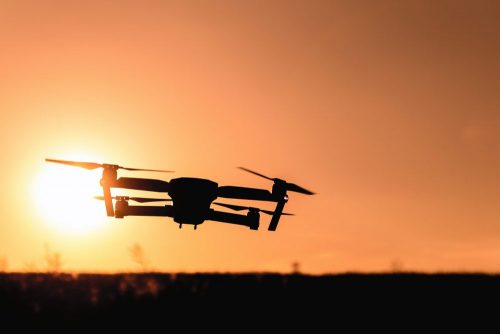Five Things you Can’t Do with a UAV or Drone In Canada
UAVs(Unmanned Aerial Vehicles) or drones are quickly becoming one of the technological wonders of the multifaceted twenty-first century. UAV’s are providing a means by which to collect efficient inexpensive information within a short period of time. A UAV offers repeatable low cost data collection in the hands of the small businesses, researchers or hobbyists.
This last year there have been significant changes made to the Canadian framework of regulations governing using UAVs in Canada.

Multi-Rotor Drone flying in the sky.
Transport Canada governs the use of UAVs in Canada and as such has rules and regulations in place to minimize the crazy consequences that can come from having a UAV but in particular:
Transport Canada’s website for flying your drone safely and legally
Interim Order No. 8 Respecting the Use of Model Aircraft
Disclaimer: The links provided have the rules for UAVs from which this article is based however, the article does not encapsulate the entirety of the rules provided by Transport Canada. This is a leisurely article and should not be used to legally document the means by which to operate a drone.
1. Can’t be Anonymous
A UAV should have a label on it that shows the name, address and telephone number of its owner. When it comes to UAVs, it is not simply good manners to label your drone but an enforced regulation. Due to their flighty nature, their ability to be hit and lost is not unlikely. Of course, actually getting your drone back depends on the good nature of the finder. However, if it so happens that you are responsible for some damage, then law enforcement will need to know to whom to address the fine. (Section 8 of the Interim Order No. 8).
2. Can’t hurt others
This one should be obvious but you cannot hurt others. It doesn’t matter if they ate the last piece of Turkey on Thanksgiving, you are not allowed to endanger the safety of other people in any capacity when you are operating a UAV. It is perhaps because of this safety factor that an operator is only allowed to operate one drone at a time. (Transport Canada).
3. Can’t interfere with a crime scene
Officially, the rule is that you cannot over or within the security parameter of a police or first responder’s operation site. This is a rule can be hard to follow because there is no sure way of knowing when the police are at crime scene as well as no definitive distance is given. As such, the signs a user should look for to indicate a police riddled situation are swarms of police officers as well loud sirens and flashy red and blue lights. (Section 5(d) of the Interim Order No. 8).

Sunset at an airport depicting multiple aeroplanes.
4. Can’t go near airports
According to Transport Canada, your drone must be 5.5 kilometers away from any aerodromes such as public airports, private airports, or seaplane base. As well as being 1.8 kilometers away from helicopter based stations such as heliports or helicopter aerodromes. (Section 5(b) of the Interim Order No. 8)
5. Can’t operate it at night
Put your night goggles away, they will not be needed here. This is a rule that is not fully comprehensive of the versatility of UAVs to operate in any condition. However, this rule may exist to protect civilians more so than the operators because they are less likely to be able to see them at night. Another interesting sky condition is that you cannot fly UAVs in the clouds which is strange but similar to the night rule and thus makes sense. (Section 5(f) of the Interim Order No. 8).
If you Break the Rules?
The department of Transport Canada distinguishes between recreational and non-recreational drone users with the penalties that it applies. So that means if you break the rules you will face different penalties. Recreational users are held to a lower standard it seems and this is reflected in the penalties. As such, the maximum penalty that can be imposed upon a recreational user is $3,000 Canadian dollars whereas a non-recreational user could face $25,000 dollars and possible jail time.
To fly a UAV in a non-recreational way, a Special Flight Operations certificate is required. The drone being flown should be either heavier than 35 kilograms or if the drone use is intended for specific professional reasons, it should still weigh more than 25 kilograms. Professional reasons can include research, surveying, inspecting, first responding, conducting academic research, farming, aerial photography or videography.
The future has arrived and with it, infinite possibilities in which drones can be used. As such, it is our responsibility as citizens to follow the rules with care so that instead of being scared of the future, we can embrace it.









Always good to see more education on UAV regulation… some inaccuracies in your last section discussing weight, to be clear. When using UAVs for commercial purposes, the SFOC process also applies to drones between 1 and 25 kg if you cannot meet the exemption requirements. Also your readers should know that if you do go through the appropriate permit process, you can get permission to fly at night and also to fly near airports. These two things are definitely not allowed recreationally but your target audience here are professionals more likely to use drones to capture geospatial data for work, so that distinction should be clear.